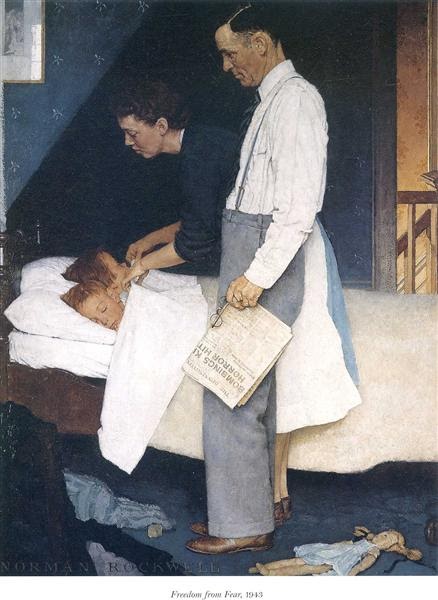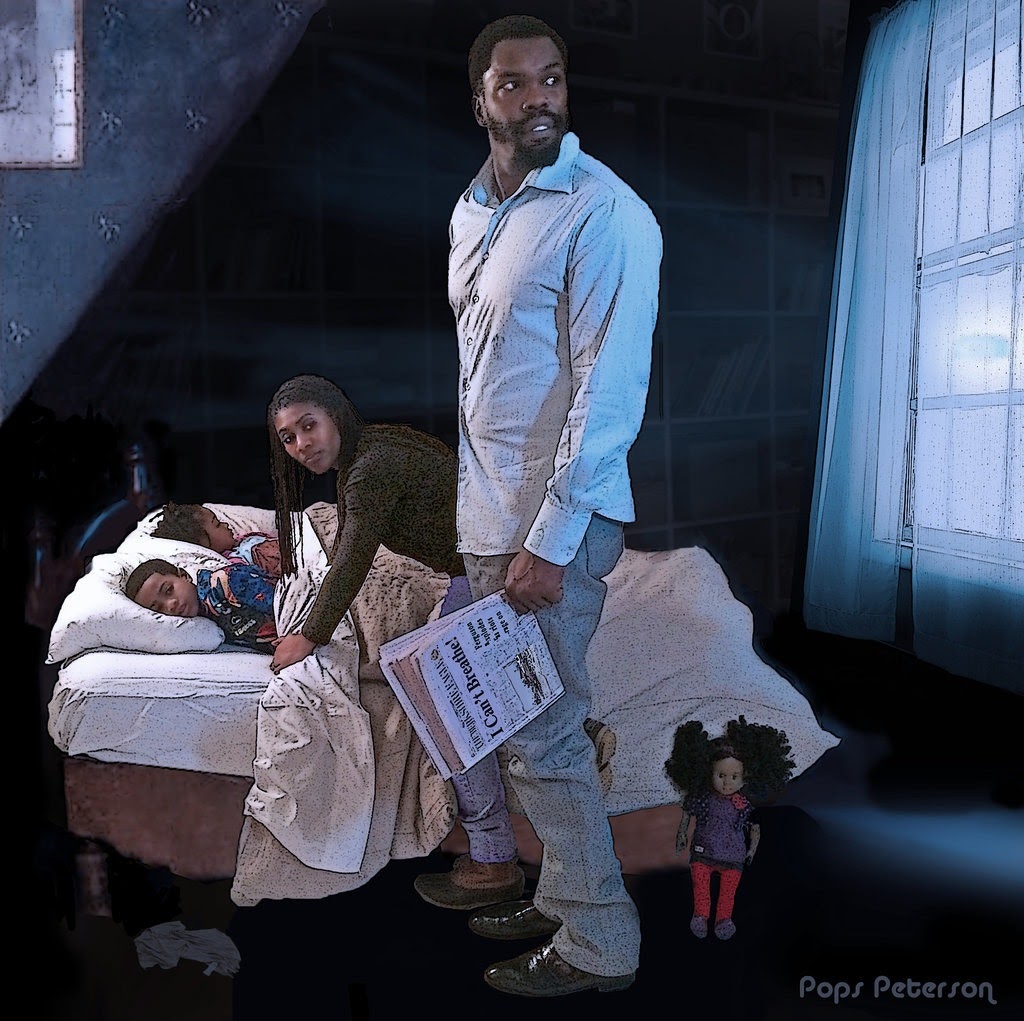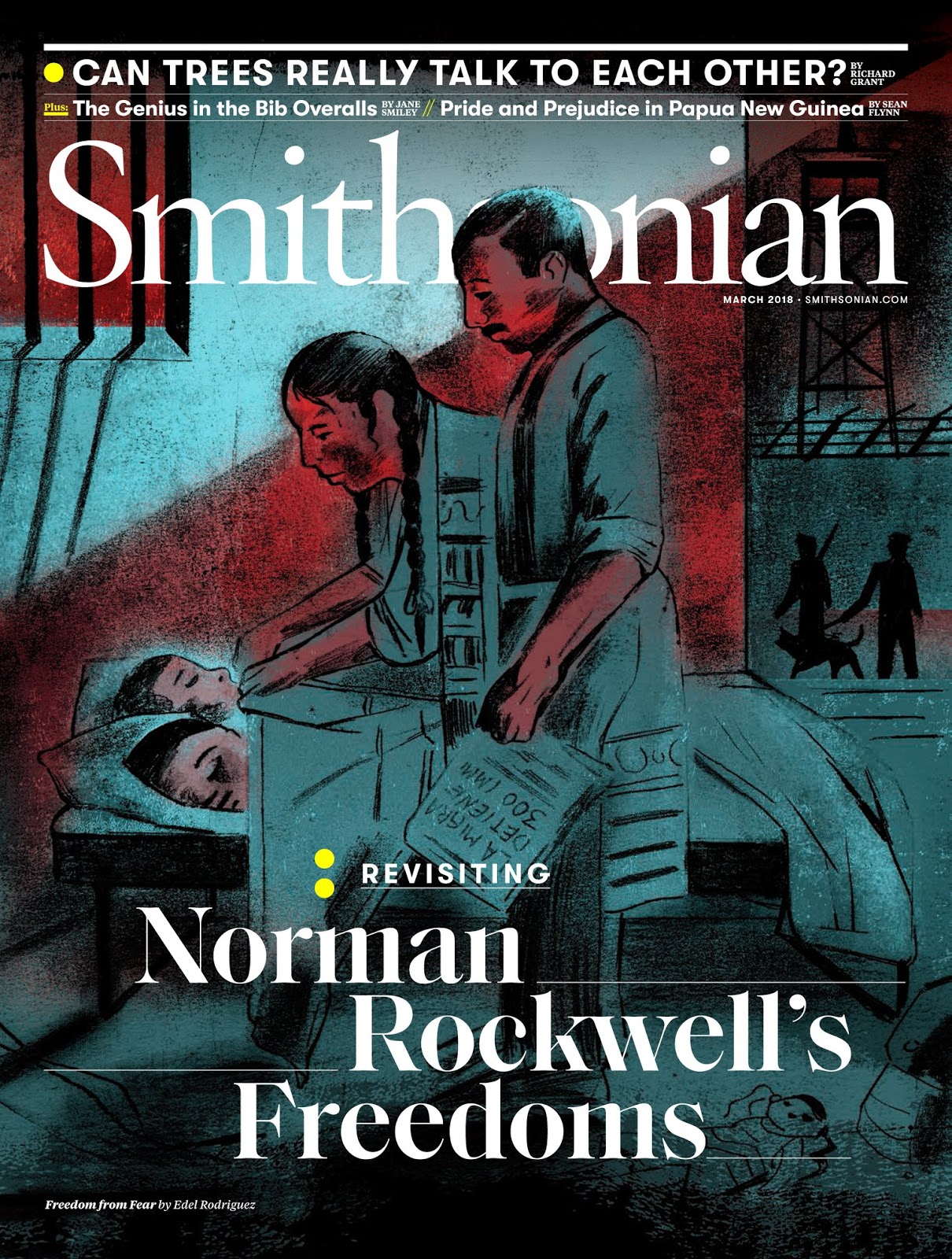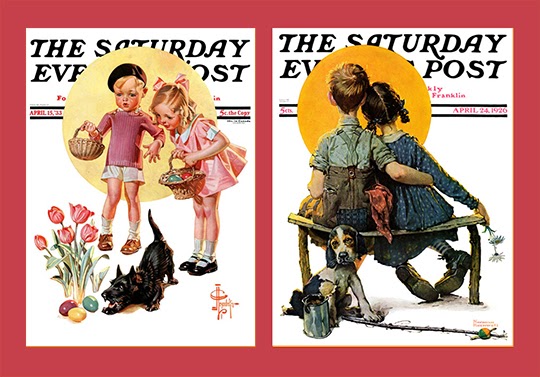
Norman Rockwell, Freedom from Fear, 1943.
Both the Easter narrative of Jesus’ crucifixion and resurrection and Franklin Delano Roosevelt’s State of Union address are underlined with a message of hope. In his speech, FDR enumerated the four fundamental freedoms that all people should enjoy, appealing to the Americans to support the war effort in order to spread the freedoms enjoyed by Americans elsewhere in the world. As a precursor to the United Nations’ Universal Declaration of Human Rights, the legacy of the four freedoms is central to American political philosophy. The first tenet of Christianity is the belief that Jesus’ sacrificial death resulted in the potential for eternal salvation, freeing humanity from sin. Likewise, FDR’s freedom from fear has been specified in the consequent UN resolution to be the freedom from aggression via the reduction of armaments, aka the collective transgressions of the world.

Pops Peterson, Freedom from Fear, 2015.
Norman Rockwell’s painting Freedom from Fear illustrates both the fear and the freedom, showing the destruction of the war abroad which Americans were being deployed to, and its absence at the home front. The image shows peaceful children in their slumber whilst their parents look on with worry, holding a newspaper referencing the bombing of London. Reproductions of Freedom from Fear have changed the newspaper headline to reflect our fears as a nation, from Pop Peterson’s rendition which features a black family and replaces the headline to “I Can’t Breathe” in reference to Eric Garner to an immigrant family on the cover page of the Smithsonian Magazine by Edel Rodriguez.

Edel Rodriguez, Freedom from Fear, 2018.
Though the shape of fear has changed throughout history, the hope that we can live in its absence is constant. So for this Easter, whether you’re contemplating the Resurrection or simply looking for something to cook on a Sunday afternoon, consider trying some of the recipes of Rockwell’s Easter menu, adapted from The Norman Rockwell Illustrated Cookbook

“Saturday Evening Post” April 22, 1905, covers by J.C. Leyendecker (left) and Norman Rockwell (right). Norman Rockwell Museum Collections.
- Roast Leg of Lamb
Six to eight servings
1 8-pound leg of lamb
3 tsp of salt
1 tsp of pepper
Mint jelly or
Gravy
2 tbsp of flour
1 bay leaf
1 tsp of minced onion
- Preheat oven to 325 F
- Wipe lamb with damp cloth. Do not remove the fell, or outer fat.
- Combine salt and pepper and rub the mixture all over the lamb.
- Insert a meat thermometer into the fleshy part away from the bone.
- Place on a shallow roasting pan and roast uncovered into oven for 2 ½ to 3 hours, until the temperature reaches 175 F for a medium lamb or 180 F for well-done.
- Serve with mint jelly or gravy.
- For the gravy, take 2 tablespoons of drippings from the roasting pan and stir in flour until smooth.
- Gradually stir in 2 cups of cold water. Add the bay leaf and onion and bring to a boil, stirring constantly.
- Reduce the heat and simmer for 5 minutes.
- Fresh Asparagus with Cream Sauce
Four servings
2 pounds asparagus
¼ cup butter
¼ cup all-purpose flour
¼ cup milk
¾ cup half-and-half
2 hard boiled eggs, minced
2 tbsp lemon juice
- Cook asparagus in boiling water and set aside, keeping it warm.
- Melt butter over a double boiler over hot water. Gradually add in flour then milk and cream, stirring constantly.
- Cook over low heat until smooth and thick.
- Reserve 1 tsp egg and add remainder to the mix.
- Place asparagus in a serving dish and top with lemon juice. Pour sauce in a gravy boat and garnish with the reserved egg.
- Carrot Mold
Six to eight servings
12 carrots
½ cup of cream
½ cup of cracker crumbles
3 eggs, separated
Salt and pepper to taste
- Preheat the oven to 350 F.
- Cook and mash carrots. Add in cream, cracker crumbs, butter, beaten egg yolks, salt, and pepper.
- Beat egg whites until stiff and gently fold into carrot mixture.
- Place in buttered ring mold set with hot water and bake for 30 minutes.
- To serve, turn out mold and add an optional garnish of a green vegetable in the center.
- Rice Pilaf
Five or six servings
4 tbsp butter
1 medium onion
1 clove garlic
1 cup long grain rice, dry
6 coriander seeds
1 stick cinnamon or 1½ tsp of ground cinnamon
4 whole cloves or ¼ tsp of ground cloves
1¼ cup water or stock
- Melt butter in a pan. Add in onion and garlic and cook until soft.
- Add in rice and toast until it begins to take on color. Add in coriander, cinnamon, and cloves.
- Cover with water or stock and simmer gently, covered.
- Polish Easter Cake
Eight servings
¼ cup milk
½ cup granulated sugar
½ tsp salt
¼ cup butter
¼ cup warm water
1 package of active dry yeast
2 eggs, beaten
2½ cups all-purpose white flour
½ cup raisins
½ tsp of lemon zest
1 cup confectioner’s sugar
1 tbsp milk
Glace cherries to garnish
- Preheat the oven to 350 F.
- Scald ½ cup milk. Stir and sugar, salt, and butter and set aside to cool to lukewarm
- Pour lukewarm water into a large bowl and sprinkle yeast over water. Stir until dissolved.
- Add yeast, eggs, and flour into the cooled milk mixture and beat vigorously for 5 minutes. Cover and let it rise in a warm place for around 1½ hours or until it has doubled in size.
- Stir down the batter and beat in almonds, raisins, and lemon zest. Pour batter into a greased and floured 1½ quart Charlotte mold or deep cake pan.
- Bake for 50 minutes and let cool for 20 minutes before removing from the pan.
- To make a glaze, whisk confectioner’s sugar into 1 tbsp of milk.
- To serve, place cake on top of serving platter, drizzle with glaze, and garnish with cherries.
Sources
- Deputy Secretary General of the UN, Jan Eliasson. Help Create World Where Four Freedoms Is ‘More Than a Monument, But a Way of Life Everywhere’, Says Deputy Secretary-General at Human Rights Day Event, 2015. https://www.un.org/press/en/2015/dsgsm924.doc.htm.
- Holson, Laura M. “Reimagining Norman Rockwell’s America.” New York Times. November 8, 2018. https://www.nytimes.com/2018/11/08/arts/norman-rockwell-freedom.html.
- Tucker, Abigail. “A 21st Century Reimagining of Norman Rockwell’s ‘Four Freedoms’.” Smithsonian Magazine. March 2018. https://www.smithsonianmag.com/arts-culture/21st-century-reimagining-no….









